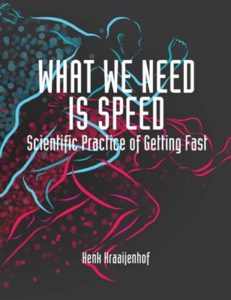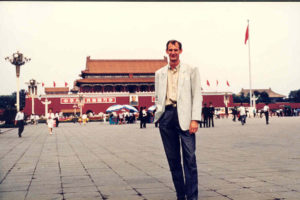Book
Yes, hard to believe but my first book about sprinting came out last week. It isn’t meant for sport scientists. Coaching (sprints) still is more of an art than a science. Averaged values and generalized principles hardly play a role in daily coaching. Especially when we are working with individuals who are very unique in many aspects.

As a young coach (full of knowledge from books and research) I learned that many things applied to the average athletes I was coaching at that time. But when I encountered my first really gifted world-class athlete, and let’s call here athlete A, my knowledge failed me. I did not know she would become world-class at the time. I only knew she was different form the average athletes I was coaching so far.
Everything I had learned to be valid, true and effective did not apply to this unique specimen. I had to come up with creative solutions to the problem of not running fast enough. At that time, in the beginning of the nineteen eighties, not much had been written about coaching elite sprinters. By thinking and trial-and-error I found a better way to coach this particular athlete and yes, world-class she became. This had never been explained to me by the books I read nor the teachers I listened to.
When I was asked to coach an even faster female sprinter, let’s call her athlete B, I first hesitated. My experience level was just over 11 seconds, not 10.80’s. But armed with my new experiences, I decided to take on this new challenge. I was in for a shock again because the experience with athlete A did not at all help me at all. Everything I learned from athlete A to be useful for her, did not work for athlete B. Needless to say that also my textbook knowledge from the past did not help me at all.
Then for me the light started blinking: maybe we have to look on a strict individual basis. Information derived from experiments with average athletes, sports students, or even patients, might not one-on-one apply, be useful or effective for coaching genetic exceptions. And experience derived from working with athlete A, might not apply to athlete B at all.
Here is the synopsis: develop your program, based on the athlete, don’t develop your athlete based on your program!
http://www.uaconceptsstore.com/product-p/what-we-need-is-speed.htm
Shanghai
I was invited to come to China to lecture at the Shanghai University of Sports. Quite an honor and a challenge. I have been in China before and have very fond memories of that trip. It was in 1990, when I was Director of Coaching in Oman and Oman participated in the Asian Games, staged in Beijing, probably as a rehearsal for the Olympic Games to come in 2000.

It was perfect, one of the smoothest competitions, I have ever visited. In perspective, maybe not a miracle, if one can run a country of a billion people, you have to be able to run a sports competition one should say. The logistics and organization should be a piece of cake. But It wasn’t only that – it was also the people, the hospitality and the incredible drive to assist us where they could.
I came back with a very positive first-hand experience of China. And yes, my athlete won a gold-medal, but that was something I already got used too.
Now 26 years later, a positive surprise again, China made a huge leap forwards. In many aspects China is setting course for the future. Apart from the development of the metropole that Shanghai is, almost 25 million inhabitants more than the whole of the Netherlands or the whole of Australia, it felt like being in European city or a city like Melbourne, Sydney, New York or Los Angeles.
The magnetic high-speed train from the airport to the city, the ultramodern high-rise buildings, everything breathes the air of a city for the future. Of course like any large city Shanghai has its problems and so does China. But at least they are trying hard and they are making headway.
The sports university is large, 4000 students, with big sports complexes for indoor and outdoor sports.
There is a mix of high-tech and valued culture, state-of the-art lecturing halls and typical Chinese gardens for students and the teachers to relax.
I realize my presentations must have been sort of a shock for some coaches. Coming from a very small country we have very few athletes and therefore have to take very good care of them and not to lose them. In a country with the population of China, for every talent we have in the Netherlands they must have 100 talents of the same level. The same applies to the USA and to Russia.

This advantage can backfire since the development process might become a kind of survival-of-the -fittest. When all athletes are given the same hard training program, only the very strongest will survive and they will be very good. But wouldn’t China be better off when 20, 50 or even 80 athletes of those hundred do well instead of only a handful “survivors”? The fact that there will always be a handful of very good ones left, disguises the weakness of this concept. Having so many athletes is a luxury, a luxury that creates the danger of coaches not having to adapt, to change, to develop, to be open-minded or to be creative. No matter what there will always be a few athletes left.
The reality of elite sports is hard. The excellent hurdler Liu Xiang probably was the best hurdler we ever saw. Still he did not get a medal during the Olympics in London in 2012, due to an injury, and even worse, he also did not win a medal in Beijing during the Olympics in 2008, again due to an injury. All of this after already winning the Olympic gold medal in Athens in 2004. I am not saying he would have won the gold in both cases but he certainly had the potential to do so.
Most athletes as this level are not reaching their full potential due to training too little, training being too easy or undertraining. It is overtraining that leads to flat performances, to fatigue, to acute or chronic injuries, stopping athletes to unfold their full potential. In my opinion this is where a tremendous gain is still to be made.
I would like to thank my Chinese friends for their hospitality, they turned this trip into a delight.
Thanks Tom, Naomi, Zack and Kiki!

